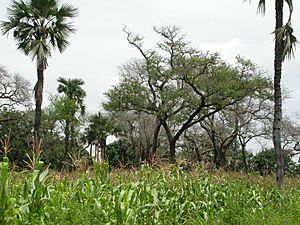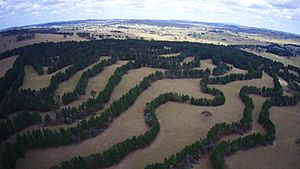Agroforestry facts for kids

Agroforestry is a special way of using land where trees or shrubs are grown together with crops or grasslands for animals. It mixes ideas from farming and forestry to create land systems that are more diverse and helpful.
This method helps farms make more money and protects nature. It stops soil erosion, creates homes for wildlife, and helps manage animal waste. Agroforestry also increases the variety of living things (biodiversity), makes soil healthier, and helps store carbon.
Trees in agroforestry systems can also give us wood, fruits, nuts, and other useful products. This way of farming is very common in warm, tropical places, especially on small farms. It's also used in the USA and Europe because it helps the soil and can even reduce the effects of droughts.
Agroforestry is similar to intercropping, which means growing different crops together. But agroforestry can be much more complex. It can include many layers of plants and hundreds of different species. It can also use plants that add nitrogen to the soil, like legumes, making the soil more fertile.
What is the Science Behind Agroforestry?
Agroforestry is based on ecology, which is the study of how living things interact with their environment. This means it helps with things like recycling nutrients and carbon in the soil. It also helps soil hold water and creates diverse habitats for plants and animals.
Agroforestry protects soil from water and wind erosion. It is one of the main ways we use land for farming, along with regular farming and forestry.
Scientists are still learning about all the ways agroforestry can help. Many traditional farming methods used by local communities for generations have inspired modern agroforestry. These old ways of farming are very important for understanding and using agroforestry today.
What are the Benefits of Agroforestry?
Agroforestry systems can be better than regular farming or forestry methods. They can make land more productive and offer many benefits for people, the economy, and the environment. But these benefits only happen if the farm is managed well. This includes choosing the right trees and taking care of them.
How Does Agroforestry Help Biodiversity?
Biodiversity means having many different kinds of living things. Agroforestry systems usually have more biodiversity than regular farms. When two or more types of plants grow together, they create a more complex home for many different animals.
Agroforestry is important for biodiversity because trees create special places for many organisms, both above and below the ground. For example, in tropical areas, the number of bats and birds in agroforestry systems can be similar to natural forests. Even though agroforestry systems don't have as many plant species or tall trees as forests, they still provide food and places to build nests.
Agroforests can also act like green bridges, connecting different natural areas. This helps animals move safely between habitats.
How Does Agroforestry Help Soil and Plants?
Agroforestry systems can protect worn-out soil from soil erosion. Plants that grow close to the ground, like grasses, help hold the soil in place. This is very important for stopping erosion.
Agroforestry can also lead to cleaner water. Trees help slow down water flow and reduce evaporation, allowing more water to soak into the soil. This means less soil and fewer nutrients wash into streams.
Other ways agroforestry helps plants grow:
- It can help clean up polluted soil.
- It can make plants better at handling droughts.
- It can make crops more stable and reliable.
How Does Agroforestry Help Sustainable Agriculture?
Agroforestry systems offer many services that help make sustainable agriculture possible. Sustainable agriculture means farming in a way that protects the environment and can continue for a long time.
Here's how agroforestry helps:
- It offers different farm products like wood for fuel, medicinal plants, and various crops. This helps farmers earn money in more ways.
- It improves food security and nutrition by making soil healthier and crops more diverse. This helps farms deal with bad weather.
- It helps restore land by reducing soil erosion and managing water.
- It allows land to be used for many things, like growing crops and raising animals at the same time.
- It reduces deforestation by providing wood for fuel directly from the farm.
- It can reduce the need for chemicals like fertilizers. This is because plants are stronger against pests and ground cover reduces weeds.
- It provides space for medicinal plants, which is helpful for people who can't easily get regular medicines.
The FAO says that using agroforestry and other sustainable farming methods is very important. We need to restore damaged farmland, eat healthier, and waste less food.
Other Environmental Goals of Agroforestry
Storing carbon is a very important environmental benefit. Agroforestry can increase the amount of carbon stored in the soil and in trees. Trees in agroforestry systems can capture some of the carbon that was released when forests were cut down. They also provide extra food and products.
Agroforestry can help with other environmental goals too:
- It can reduce bad smells, dust, and noise.
- It creates green spaces and makes areas look nicer.
- It improves or maintains homes for wildlife.
How Does Agroforestry Help with Climate Change?
Agroforestry can greatly help with climate change mitigation (reducing climate change) and adaptation (adjusting to its effects). For example, a study in Kenya found that when small farmers started using agroforestry, it helped store carbon and also improved their lives. Keeping many different types of trees was important here.
In recent years, many small farmers have turned to agroforestry to deal with climate change. A study found that over half of the farms surveyed in East Africa had started planting trees. These trees produced fruits, tea, coffee, oil, animal feed, and medicines, in addition to their usual crops. Agroforestry was one of the most common ways farmers were adapting to climate change.
History of Agroforestry
Even though the scientific study of agroforestry is quite new (starting in the 1900s), people have been practicing it for centuries. Local and indigenous communities who lived closely with forests developed these methods.
For example, Native American communities used to burn oak and other habitats regularly. This method helped keep trees healthy and improved the overall environment.
Challenges of Agroforestry
Even though agroforestry has many benefits, it's not yet widely used everywhere. There are several reasons for this:
- It can be hard to find markets to sell products from agroforestry.
- People might not know much about these farming methods.
- There might be competition between trees, crops, and animals.
- It can be difficult to get financial help to start.
- It might not seem profitable at first.
- There aren't enough places to see agroforestry in action.
- It can cost more to manage the land in this way.
- Farmers might not have enough training or knowledge.
- It can be hard to find information about agroforestry.
- It might seem inconvenient to switch to this method.
- There might not be enough land for some farmers.
- It can be hard to find seeds or young trees.
Scientists and farmers are working together to find solutions to these challenges.
See Also
- Afforestation
- Carbon farming
- Deforestation
- Deforestation and climate change
- Farmer-managed natural regeneration
- Fertilizer tree
- Forest farming
- Forest gardening
- LULUCF
- Mycoforestry
- Pastoral farming
- Permaculture
- Streuobstwiese
- Sustainable agriculture
- Sustainable forest management
- Silviculture
- Silvopasture



